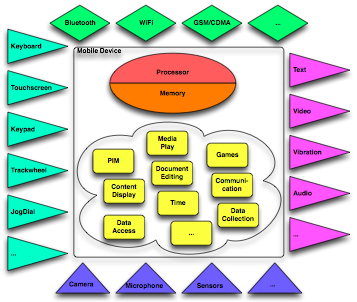In addition to working on the mobile learning report, I’m speaking on mobile to Mexico’s Tecnológico de Monterrey via videoconference next week on mobile. As an part of my ongoing efforts to capture my thinking as graphics (for lots of reasons including my visual conceptualization approach, making my powerpoints more worthwhile, communicating, etc), I took a stab at graphically representing my generic model of a mobile device:
 In this model, I’m trying to show that a mobile device is, at core, a processor and memory unit with a variety of possible means of connection (personal, local, and wide-area ways to network), input to the device (e.g. keys, touchscreen), output from the device (e.g. screen, speakers), and sensors that can do things like take pictures, capture audio, and sense position both in the larger context (e.g. GPS), and relative (like whether it’s tilted sideways or upright). Also, we have certain types of prototypical software that can be included: Personal Information Management, data viewing, capture, editing, communication, etc.
In this model, I’m trying to show that a mobile device is, at core, a processor and memory unit with a variety of possible means of connection (personal, local, and wide-area ways to network), input to the device (e.g. keys, touchscreen), output from the device (e.g. screen, speakers), and sensors that can do things like take pictures, capture audio, and sense position both in the larger context (e.g. GPS), and relative (like whether it’s tilted sideways or upright). Also, we have certain types of prototypical software that can be included: Personal Information Management, data viewing, capture, editing, communication, etc.
The point is that there are lots of form factors, but at heart we have this digital communication device with certain affordances (there’s that word again :) that we can map to our learning needs and goals. I think it’s valuable to try to abstract away from particular devices as they are continually changing (well, increasingly multi-capable), and consider more fundamentally what capabilities are available and how they might be used. What do you think?
Leave a Reply